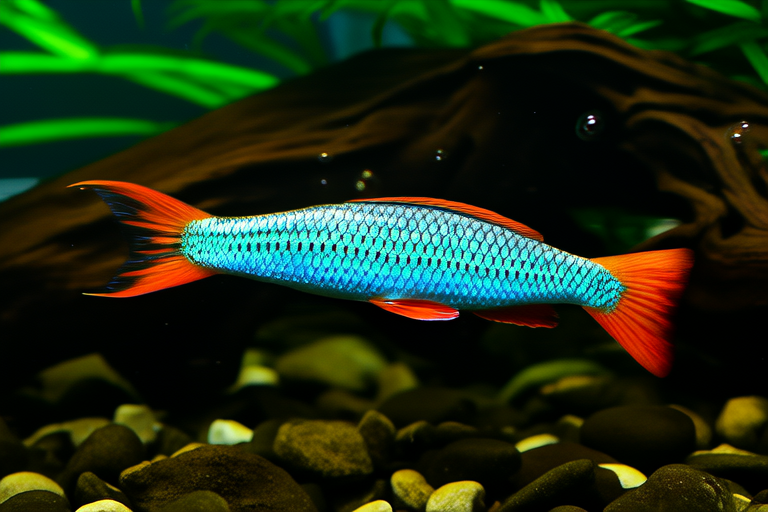Mastering the Art of Keeping Rajah Cichlids Happy and Healthy
Rajah Cichlids, also known as Aequidens rivulatus, are popular among aquarists due to their striking appearance and unique behavior. These fish are native to South America, specifically the rivers of Guyana and Suriname. Understanding their natural habitat and specific needs is crucial for ensuring they thrive in your aquarium. This guide will cover everything you need to know about keeping Rajah Cichlids happy and healthy, from water conditions and diet to tank setup and compatible tank mates.
Natural Habitat
Rajah Cichlids originate from the warm, slow-moving waters of the Amazon Basin. In their natural environment, they inhabit areas with dense vegetation, rocky substrates, and plenty of hiding spots. The rivers are typically shallow and rich in organic matter, which contributes to their vibrant colors and robust health.
Water Conditions
Maintaining optimal water conditions is key to the well-being of Rajah Cichlids. Here are some important parameters to consider:
- Temperature: Keep the water temperature between 75°F and 82°F (24°C to 28°C).
- pH Levels: Aim for a pH range of 6.5 to 7.5. Rajah Cichlids prefer slightly acidic to neutral water.
- Hardness: Soft to moderately hard water works best, with a general hardness (GH) of 5 to 12 dGH.
- Ammonia and Nitrite: Both should be undetectable. Regular water changes and proper filtration are essential to keep these levels in check.
- Nitrate: Maintain nitrate levels below 20 ppm by performing regular water changes.
Diet Requirements
Rajah Cichlids are omnivorous, meaning they eat both plant-based and animal-based foods. A balanced diet is vital for their health and longevity. Offer a variety of foods, including:
- High-quality flake food or pellets designed for cichlids.
- Frozen or freeze-dried bloodworms, brine shrimp, and daphnia.
- Vegetables like blanched spinach, zucchini, and peas.
Feed them twice daily, offering only what they can consume within a few minutes to prevent overfeeding and water pollution.
Tank Setup
The ideal tank size for a single Rajah Cichlid is at least 55 gallons, but if you plan to keep multiple individuals, aim for a larger tank of 75 gallons or more. The tank should mimic their natural environment as closely as possible:
- Substrate: Use fine gravel or sand to replicate the soft riverbeds they inhabit.
- Hiding Spots: Provide caves, driftwood, and rocks for shelter. This is especially important during breeding periods when territorial behavior increases.
- Plants: Live plants like Amazon swords, Java ferns, and Anubias are beneficial for oxygenation and aesthetic appeal.
- Filtration: Invest in a high-quality filter that provides ample biological, mechanical, and chemical filtration.
- Aeration: Ensure adequate oxygenation through a reliable air pump or strong water movement.
Compatible Tank Mates
Selecting appropriate tank mates is critical for maintaining harmony in your aquarium. Rajah Cichlids can be territorial, so choose species that are similar in size and temperament:
- Other Cichlids: Consider peaceful cichlid species such as discus, angelfish, or dwarf cichlids.
- Characins: Tetras, hatchetfish, and pencilfish can coexist peacefully.
- Loaches: Some loach species can tolerate the semi-aggressive nature of Rajah Cichlids.
Avoid overly aggressive or timid fish that may become stressed or injured. Always research the compatibility of any new additions to your tank.
Understanding Rajah Cichlid Behavior
Rajah Cichlids exhibit fascinating behaviors that can provide insight into their needs and preferences. They are generally active swimmers, often exploring their surroundings and interacting with tank decorations. During breeding, males may display brighter colors and engage in courtship rituals. Females will lay eggs in carefully selected sites, usually flat surfaces or caves.
Observing their behavior can help you identify signs of stress or illness early on. For instance, reduced activity, loss of appetite, or erratic swimming could indicate health problems. Understanding their behavior also allows you to create a stress-free environment by providing ample space, hiding spots, and minimizing disturbances.
Common Health Issues
Like all aquatic animals, Rajah Cichlids are susceptible to certain health issues. Here are some common problems and how to address them:
- Fungal Infections: Characterized by white, cotton-like growths on the body or fins. Treat with antifungal medications and improve water quality.
- Bacterial Infections: Symptoms include red streaks, open sores, or fin rot. Use antibiotics prescribed by a veterinarian.
- Ich: Small white spots appear on the body and fins. Raise the temperature slightly and treat with ich-specific remedies.
- Swim Bladder Disorder: Fish may struggle to maintain balance or swim upright. Adjust feeding practices and ensure water quality is optimal.
Preventive Care Tips
To minimize the risk of health issues, follow these preventive care tips:
- Perform regular water changes, ideally 20% weekly.
- Monitor water parameters and adjust as necessary.
- Quarantine new additions to the tank for several weeks to prevent disease introduction.
- Provide a varied diet and avoid overfeeding.
- Minimize stress by maintaining stable water conditions and providing adequate hiding spots.
Creating a Thriving Ecosystem
Establishing a thriving ecosystem requires attention to detail and dedication. Start by cycling your tank properly to establish beneficial bacteria. Introduce live plants and beneficial bacteria supplements to enhance water quality. Regularly test water parameters and make adjustments as needed. Encourage natural behaviors by providing suitable hiding spots and ample swimming space.
Engage with fellow aquarists to learn from their experiences and share knowledge. Join online forums, attend local fishkeeping clubs, or participate in social media groups dedicated to cichlid enthusiasts. Networking can provide valuable insights and support.
Conclusion
Mastering the art of keeping Rajah Cichlids happy and healthy involves understanding their natural habitat, meeting their specific needs, and creating a harmonious environment. By focusing on water conditions, diet, tank setup, and compatible tank mates, you can ensure your Rajah Cichlids lead long, vibrant lives. Remember, the key to success lies in attentive care, regular monitoring, and a commitment to providing the best possible living conditions.
